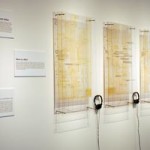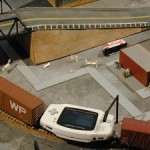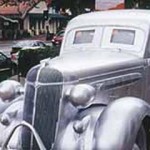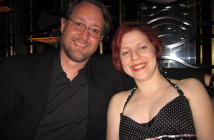The Decordova hosted the winners of the ARTCOM residency for Boston Cyberarts 2005: Jon Klima and Carrie Bodle. Klima's Train is an HO [1] scale layout featuring two sets of locomotives and cars circling through a bizarre landscape of miniature movie sets. Among the films included, seemingly at random, are Bad Lieutenant, Risky Business, And God Created Woman. The railroad junctions can be controlled remotely via cell phone. Accessing the train phone signal means that one can also "eavesdrop" on a set of conversations between the film characters. These are lines of dialogue mixed (again, seemingly at random) in a conversation generator, programmed by the artist, and also displayed on a monitor in the gallery. Additionally, each engine features a Gameboy unit on a flat car that plays scenes of landscape corresponding to whatever the train should be "seeing out its window" at that moment on the set. Klima's project is ambitious, but feels like a work in progress and inspired more questions than it answered. Why choose these films instead of anything relating to the history of trains or films centering on interesting conversations? Because the dialogue is sampled from films, the resulting conversations imply a narrative to follow, but there is no reward for eavesdropping as the characters don't seem to be speaking to one another. On the subway, I'll always wait to hear what the man in the car wielding a hammer is going to do next. No such answers were forthcoming from Klima.
Carrie Bodle's installation of audio, maps, and text notations correlates events in physical and cyber-space from a single limited period of time. She follows a fascination for publicly updatable server-sites such as Wikipedia, the online English language encyclopedia whose articles are written and amended by the general public. This presentation is like an organized dip into a field notebook of someone trying to study an elusive bacteria: Abstract, Invisible, Esoteric. Bodle plays for us a sampling of life in the cyber ether: we are listening to people sending text and information between computer servers, transcribed as carefully as possible for a conventional gallery environment. The audio consists of tonal bursts, electronic hums, and modulated static, pierced with the occasional timestamp letting you know which bursts are discrete events. None of us really have a framework for understanding computer-ese; the audience can not glean any real information from the sound, unlike the maps & text. Thus, the sound is experiential, a Cage- like collection of phenomena occurring outside the composer's control. This leads to a disjoint between the visual and audio modes of information. The maps are meta-information (that is, information about the WIKI information) and well-presented in the tradition of Tufte, geared towards making sense of the world. In contrast, the audio bursts, if viewed also as information, are confusing, but as a recording resource, they may be ripe for future sound compositions. It might also be interesting to see how (or if) Bodle documents these events on the internet, its "native" environment.
Nam June Paik's Requiem for the 20th Century is a silver painted 1936 Chrysler tricked out with video monitors on three sides and Mozart roaring out the stereo system. It was interesting to consider Paik out of doors since Nor-Easters are not so good for video equipment. Paik's Chrysler becomes a monument to American industry and the sexy noir years of film, and simultaneously a ghost hearse as it recalls the 1934 death car of Bonnie & Clyde. Mozart's Requiem is a difficult piece of music to hear next to anyone's artwork because it seems so unassailable. There are no Paik interventions like bubblegum on the Brahms record here. Paik's video landscape inside the car featured clips of many familiar works including projects with Charlotte Moorman and David Bowie. In whole, Requiem is a Paik-styled time capsule, mourning both the 20th century and Paik's long career in that century.
(My thanks to Bob Harris for the discussion on Paik.)
[1] - For model train enthusiasts HO is the size of track and rolling stock.
- Carrie Bodle, Wiki, 2005.
- John Klima, Train, detail, 2004.
- Nam-June Paik, Requiem For The 20th Century
Links:
The DeCordova Museum and Sculpture Park
"Artist in Residence at Technology Companies of Massachusetts" (A.R.T.C.O.M.)" is on view April 9–May 1 at The DeCordova Museum and Sculpture Park.
Nam-June Paik's "Requiem For The 20th Century" is a new addition fo the DeCordova Scuplture Park.
All images are courtesy of The DeCordova Museum.





